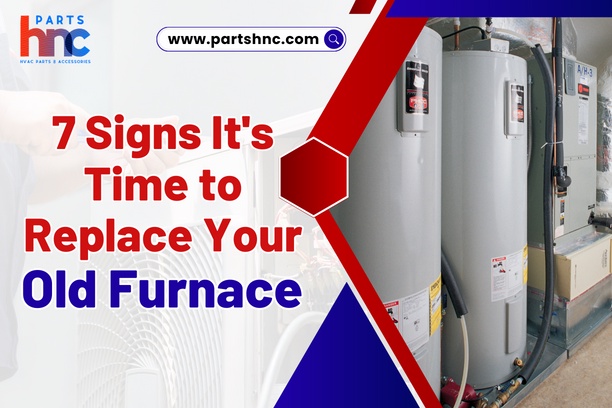As the colder months of the year approach, now is the time to check that your home's heating system is ready for the season. It could be time to replace your old furnace if it isn't working properly. Any furnace, whether it's made by Lennox, Carrier, Trane, or another company, will wear out and need to be replaced at some point.
In fact, even with regular maintenance, furnace parts can wear out over time, resulting in decreased efficiency and higher energy bills. In this article, we'll explore how old is my furnace and the seven signs that it's time to replace your old furnace. So you can stay warm and comfortable all winter long while also saving money on your heating costs.
|
Table Of Contents: |
How old is your furnace?
The average lifespan of a furnace from Lennox, Carrier, Trane, or other similar manufacturers is typically around 15-20 years. However, this lifespan can vary depending on several factors, including how well the furnace is maintained, how often it is used, and the quality of the Lennox furnace parts. If a furnace is not maintained properly or is used excessively, it may not last as long as expected.
Here’s how to determine how old is my furnace:
- You need to find the serial number on the unit.
- Typically, the date of production is embedded in the serial number.
- Once the serial number is located, the date of manufacture can be deciphered using a database or by contacting the manufacturer directly.
- To find out how old your furnace is, check the documentation that came with it when you had it installed or the manual.
Signs that indicate the replacement of your old furnace
As we know, furnaces are not designed to last forever. Over time, they can become less efficient and break down, leading to costly repairs and energy bills. Knowing when to replace your old furnace can save you money and ensure your family's comfort. Here are the seven signs that indicate it's time to replace your old furnace:
-
A Rise in Energy Bills
After about 15 years of use, a furnace reaches its maximum efficiency and begins to have trouble heating a home uniformly. The cost of your monthly energy bill will skyrocket as a direct result. When deciding whether or not to replace your furnace, you should look at the cost of the next repair.
The furnace should be replaced if the cost of repairs is going to be more than half the price of a new one. If your furnace is malfunctioning, now is a good time to look into alternatives like radiant heating, ductless systems, or zone control systems.
Repairing an older furnace is recommended if it is less than ten years old and experiencing common problems. A simple calculation can help you determine if it's time to invest in furnace repair: Repair costs are reasonable if they can be multiplied by the furnace's age and come out to under $5,000. Repairing a 7-year-old furnace that has a $400 repair bill due to faulty burners is probably a good investment. (7 x 400 = 2,800.)
PartsHnC offers a wide range of furnace parts and accessories from trusted brands such as Carrier, Lennox, Trane, and many more. Whether you need a new blower motor, igniter, control board, or any other component for your furnace, we've got you covered.
-
Are you having to make frequent repairs?
If your furnace needs pricey repairs, it may be time to replace it rather than keep it in working order. If your furnace is over 20 years old and you're spending a lot of money on repairs, it's time to get a new one. If the furnace is only going to last a few more years, it is not worth spending a lot of money on repairs.
High repair costs may be justifiable for furnaces less than 15 years old if doing so will extend their useful life by at least that much. However, in models with a lower efficiency to begin with, this may be impossible.
-
Are there cold spots in your home?
Uneven heating throughout the house is a sure sign that something is wrong with the furnace. Locations far from the heating source or drafty windows and doors are just two of the most common sources of cold air in your home. The furnace isn't doing its job properly if it leaves some rooms colder than others. The air filter may be dirty, the vents or ducts may be blocked, or the furnace may be too small to handle the space.
Having a professional HVAC technician inspect your furnace to find out what's causing cold spots and what can be done about it is a must if you've noticed any of these things. When it comes to restoring the comfort and energy efficiency of your home, a simple repair may be all that's needed in some cases, while in others, a replacement will be required.
-
Are there strange noises or smells coming from your furnace?
When your furnace makes noise, it may be time to get it checked out. When should you replace your heating system? If your furnace is making any of the following noises, it may be time to replace it: rattling, popping, humming, or screeching. If you want to reduce your monthly energy costs, replacing your furnace with a boiler, heat pump, or ductless mini-split system could be a good option.
Here are some furnace noises and what they mean:
Popping Noise: The popping noise you hear is the result of temperature fluctuations in your furnace. Temperature-sensitive components are to blame for the popping sound.
Rattling Noise: Loose ducts or machinery could be the cause. If you are unsure if your furnace needs to be replaced, it is best to consult a professional.
Screeching Noise: If your furnace is making a screeching noise, the blower motor is probably broken. However, a broken belt or pulley on your old heater can have the same effect.
Humming Noise: The normal operation of the furnace blower motor results in a humming noise. If the noise level continues to rise, it may be time to replace the furnace.
Clicking Noise: If you hear a clicking sound coming from your flame sensor or igniter, it may be time to get them serviced. Fortunately, this noise is fairly typical, and it can usually be remedied by means of a routine furnace repair.
Booming Noise: A booming noise coming from your furnace could indicate a serious problem with gas emissions. Short delays in the ignition process are common culprits in producing this noise. However, if you smell gas after turning off the furnace, it's time to call in the pros to replace the unit.
-
Are there safety concerns?
An old and malfunctioning furnace can pose significant safety concerns in your home. A furnace that is not working correctly can release harmful gasses, such as carbon monoxide, into your home, which can be life-threatening. Carbon monoxide is odorless, and colorless, and can cause flu-like symptoms, headaches, and even death. An old furnace may also have faulty wiring or electrical issues that can cause fires or electrical shocks.
Additionally, a furnace that is not functioning correctly can put a strain on the system, causing it to overheat and potentially causing damage to the furnace or other parts of your home. It's crucial to have your furnace inspected regularly by a professional HVAC technician to ensure that it's functioning correctly and safely. If you notice any warning signs of a malfunctioning furnace, such as unusual sounds, smells, or cold spots, you should turn off the furnace immediately and seek professional help.
-
Are replacement parts becoming difficult to find?
If your furnace is old and outdated, finding replacement parts can become increasingly challenging as time goes on. As manufacturers discontinue certain models and produce new ones, the availability of replacement parts for older models can become scarce. This can lead to longer wait times for repairs and higher costs for replacement parts.
Additionally, even if replacement parts are available, they may not be as efficient or effective as newer components, which can impact your furnace's overall performance and energy efficiency. If you're struggling to find replacement parts for your old furnace, it may be time to consider upgrading to a newer, more efficient model that is easier to maintain and repair.
Keeping your furnace in good condition is crucial for maintaining a warm and comfortable home during the cold months. However, even with regular maintenance, furnaces eventually wear out and require replacement. If you notice any of the seven signs we discussed in this article, it's time to start replacing your old furnace.


Comments (1)